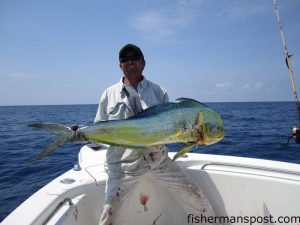Carolina Beach June 13, 2013

Tracy McCarter with a dolphin that bit a blue/white skirted ballyhoo while he was trolling near the Steeples aboard the “Sarah’s Worry Too.”
Kyle, of Island Tackle and Hardware, reports that the flounder fishing is picking up (with anglers weighing several 5-6 lb. fish this past weekend). Most are coming from structure in the ICW and Cape Fear River, and they’re falling for live menhaden or mud minnows. Gulp baits will also tempt bites from the flatfish.
Speckled trout are feeding around grass islands and hard structure in the river, where live baits, soft plastics like D.O.A. Shrimp, and suspending hard baits like MirrOlure MR17’s are all effective.
Anglers are finding decent numbers of red drum feeding in the bays off the lower river, where they’ll bite topwater plugs, soft plastics, or live baits.
Cobia are feeding within a few miles of the beachfront and at nearshore structure in the ocean, and anglers can fool them with live baits or sight-cast bucktail jigs and soft plastics.
Spanish mackerel fishing has been a bit slower since last week’s storm dirtied the water, but anglers who can find clean conditions should be able to find the spaniards as well. Trolling Clarkspoons or casting metal lures like Gotcha plugs at surface activity will put the little mackerel in the boat.
King mackerel and some dolphin are feeding in the 20 mile range, where they’ll bite live baits or dead cigar minnows and ballyhoo.
More dolphin, some wahoo, and billfish are on the feed out in the Gulf Stream. Ballyhoo paired with skirted trolling lures will fool all the blue water predators.
Jeff, of Seahawk Inshore Fishing Charters, reports that anglers are still catching decent numbers of red drum in the backwaters off the lower Cape Fear River. The fish are feeding in the creeks and bays, with some schools working the shallow flats in the area. Topwater plugs and Gulp and D.O.A. soft baits are fooling most of the fish, but anglers are also connecting on live mud minnows and shrimp pinned to Carolina and float rigs. A few flounder and speckled trout are feeding in the same areas and biting the same baits.
Sheepshead are beginning to show up around inshore structure like pilings and rockpiles, where they’ll bite live fiddler crabs. A few black drum are mixed in.
Flounder fishing is still a bit slow, but anglers are picking up a few on Gulp baits and live peanut menhaden around creekmouths, points, and structure like docks.
Tripletail have shown up around crab pot buoys in the lower Cape Fear River. Anglers can tempt them to bite live baits under float rigs.
Robert, of Carolina Explorer, reports that last week’s tropical storm muddied up the water and has slowed fishing a bit, but anglers are still putting some fish in the boat in the ICW and Cape Fear River.
Red drum continue to feed in the bays and creeks off the lower river, where anglers can tempt them to bite live mud minnows, shrimp, or Gulp baits. Topwater plugs can also be effective in the early morning hours and on overcast days.
Speckled trout are feeding in the river as well and taking up station in more open water as the temperatures rise. Targeting grass banks and points, oyster bars, and anything that creates a current break is the way to find the trout. Anglers can then tempt them to bite live baits, soft plastics, and (occasionally) topwater plugs.
Robin, of Carolina Beach Pier, reports that anglers are connecting with some spanish mackerel and bluefish while working Gotcha plugs from the pier.
Some sea mullet are taking an interest in double-hook bottom rigs baited with shrimp.
Jessie, of Kure Beach Pier, reports that croaker are biting shrimp and other baits on bottom rigs.
Some flounder are taking an interest in small live baits fished under the pier.






